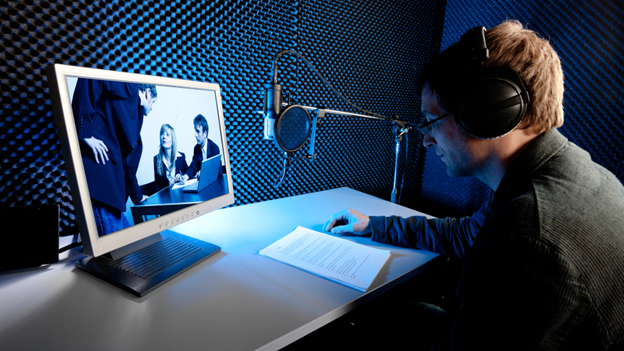A Media Localization Primer – Types, Challenges and Future Avenues

Media localization is the process of adapting audiovisual content to meet the linguistic, cultural, and technical requirements of a specific region or country. By localizing media content, companies can increase their reach to new markets and target audiences. This is particularly important in today’s globalized world, where video content accounts for 90% internet traffic and where video is the #1 source of information for 66% people1. According to Social Media Today, 93% of businesses gain new customers as a result of branded video content. Wordstream found that the revenue of marketers who use video grows 49% faster compared to the ones who don’t. Wyzowl reported that 87% of marketers say videos have a good ROI. So if you are not taking advantage of audiovisual media yet, you are missing out on new opportunities.
There are three main types of media localization: (1) subtitling & captioning, (2) dubbing, and (3) voice-over. The type of media localization used depends on the preferences of the target audience, the budget and the type of media content itself – be it entertainment, corporate or educational videos, marketing or advertising content, to mention just a few possibilities. Each type of media localization has its own advantages and disadvantages, and it is up to the company to decide which type is best for a particular project, target audience and situation.
The cost of localization varies depending on the type of localization and the volume of the audiovisual content to be localized. Subtitling is generally the least expensive form of localization, while dubbing is often the most expensive. Voice-over falls somewhere in between.
Subtitling and Captioning
Subtitling is the process of adding text to a film or video in a foreign language, for example English subtitles to a Spanish-language video. It is probably the most common form of media localization. Advantages of subtitling include that it is authentic as it preserves the original sound and music, and that it is relatively inexpensive compared to other forms of localization, especially lip-sync dubbing.
Captioning is the process of adding text to videos in the same language, for instance English captions to an English-speaking video. Captions are typically created with deaf and hard of hearing viewers in mind and as such they include sound and speaker identifiers.
Captioning is the term used in the US, Canada and Australia, whereas in Europe people tend to talk about “subtitling for the deaf and hard of hearing” (SDH).
In today’s digital world, companies are using social media, websites, YouTube, and other platforms to reach their target audiences. However, not all individuals may be able to hear the soundtrack. This is why it is important to add captions (or SDH subtitles) to any video content. Captioning provides a means of access to audio and visual content for individuals who are unable to hear the audio portion of a film or video or who are watching the video content with the sound off. Captions can therefore help to make the content accessible to a wider audience. They can also be beneficial for people who are learning a new language.
Subtitling and captioning are two important components of media localization, and they bring a number of benefits, not only for the media and entertainment industry, but also for the corporate industry, including:
- Improved accessibility: Subtitling and captioning make media content accessible to a wider audience. This can help to create a more inclusive and accessible workplace.
- Increased search engine optimization (SEO): Subtitling and captioning can help to increase SEO. This can improve the visibility of the content on search engines and drive more traffic to the website.
- Increased reach: Subtitling can also help to increase the reach of media content, as it can be viewed by individuals in different countries in different languages.
- Captions can also be later used as a transcript and metadata.
If you are wondering which type of media localization to choose, subtitling and captioning are an obvious choice. You can only gain by adding them to your audiovisual content. So, regardless of whether you decide to use dubbing or voice-over in different locales, adding subtitles or captions to your videos will help you gain and retain more viewers.

Dubbing
Dubbing is the process of replacing the original soundtrack of a film or video with a new one in a different language. The main advantage of dubbing is that it is more immersive for the viewer, as the audio is in their native language. It does not require splitting viewers’ attention between following the on-screen action and reading the translated text, as is the case with subtitling. On the downside, dubbing can be expensive and time-consuming, and it can also detract from the original performance of the actors.
The most important characteristics of dubbing include the requirement of matching the translation to the lip movements of the original actors (known as lip sync) and timing (isochrony). This means that translation has to fit into the lip movements of the original utterances as well as match precisely their the duration.
Lip-sync dubbing is the most expensive type of media localization. It is recommended for premium content, such as high-profile public-facing media, marketing or entertainment content.

Voice-over
Voice-over is the process of adding a voice in a foreign language to a film or video, while the volume of the original soundtrack is lowered, but is still audible. This is often used for documentaries, educational or corporate videos, and non-fiction genres in general. The main advantage of voice-over is that it is less expensive than dubbing. On the downside, voice-over may be less immersive for the viewer, especially if the voice reading out the translation does not match the original.

Audience preferences
The prevalence of each type of localization varies depending on the country, language and the audiovisual media and whether you are watching something on TV, cinema, streaming services or social media. In some countries, subtitling is the preferred form of localization, while in others, dubbing is more common. For example, in Scandinavian countries subtitling is more common, while in France, Germany, Italy or Spain, dubbing is preferred. Dubbing is also widely used in Russia and China. In social media, subtitling is the most prevalent type of media localization.
However, given recent changes in the audiovisual landscape, especially the rise of OTT platforms and streaming services, such as Netflix, Amazon Prime or Hulu (which offer viewers a choice of which media localization type they can switch on for any given show), we have also seen a change in viewers’ preferences and film watching habits. A recent study by Preply has shown that Gen Z and millennials overwhelmingly prefer to watch videos with the subtitles on. We have also witnessed an unprecedented growth of dubbing into English, pioneered by Netflix. Viewers seem to want to watch more and more content in their own language.
Legal requirements
The rise of subtitling and captioning has also been fostered by legal regulations on media accessibility. In many countries, captioning is legally required for media content. This requirement is in place to ensure that media is accessible to individuals who are deaf and hard of hearing. The requirements for captioning vary from country to country, but in general, they stipulate that a certain percentage of media content must be subtitled for accessibility.

Automation
The future of media localization holds exciting opportunities with the advancements in technology and automation. Some key avenues for future development in media localization include:
- Automated transcription and timing in subtitling and captioning: Technology is becoming increasingly accurate and able to process large amounts of audio and video content in a short amount of time. This has the potential to significantly speed up and streamline the localization process.
- Speech-to-text and text-to-speech systems: The development of speech systems is advancing rapidly, and has the potential to revolutionize the way media content is localized – both for media localization and for accessibility. These systems can automatically transcribe speech into text, thus creating automatic subtitles, or generate audio for subtitling (“audio subtitling”), voice-over or even dubbing.
- Machine translation: Machine translation systems are also becoming better and better, and have the potential to provide quick and accurate translations for a wide range of languages. This can greatly improve the speed and efficiency of the localization process.
- Video synthesis technology: Did you know that you can use naturalistic human avatars – or create your own avatar! – to localize video content into multiple languages? This solution has great potential especially in educational, training and corporate videos and can help you reduce the cost of video recording, editing and translation.
In conclusion, the future of media localization is characterized by the rapid advancement of technology and automation. The localization process is becoming faster and more efficient, making audiovisual media more accessible to wider audiences. As these technologies continue to advance, the future of media localization looks promising and is sure to bring many exciting new opportunities.
References:
1. https://techjury.net/blog/video-consumption-statistics/#gref
Disclaimer: Copyright © 2021 The Localization Institute. All rights reserved. This document and translations of it may be copied and furnished to others, and derivative works that comment on or otherwise explain it or assist in its implementation may be prepared, copied, published, and distributed, in whole or in part, without restriction of any kind, provided that the above copyright notice and this section are included on all such copies and derivative works. However, this document itself may not be modified in any way, including by removing the copyright notice or references to The Localization Institute, without the permission of the copyright owners. This document and the information contained herein is provided on an “AS IS” basis and THE LOCALIZATION INSTITUTE DISCLAIMS ALL WARRANTIES, EXPRESS OR IMPLIED, INCLUDING BUT NOT LIMITED TO ANY WARRANTY THAT THE USE OF THE INFORMATION HEREIN WILL NOT INFRINGE ANY OWNERSHIP RIGHTS OR ANY IMPLIED WARRANTIES OF MERCHANTABILITY OR FITNESS FOR A PARTICULAR PURPOSE.


